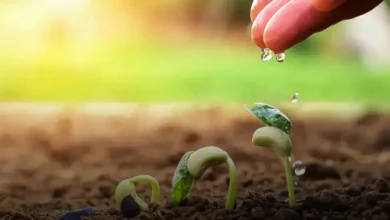Calibrachoa (Calibrachoa x hybrida)

Calibrachoa (Calibrachoa x hybrida) é uma planta muito apreciada por jardineiros e paisagistas devido à sua beleza e facilidade de cuidado. Com flores que se assemelham às petúnias, a Calibrachoa é uma excelente escolha para quem deseja adicionar cores vibrantes e alegres ao jardim.
Esta planta, nativa da América do Sul, é conhecida por sua habilidade de se adaptar a diferentes condições climáticas e sua capacidade de florir abundantemente durante toda a estação de crescimento. Com a devida atenção e cuidado, a Calibrachoa pode se tornar o destaque de qualquer jardim ou paisagem.
Introduction to Calibrachoa Care and Growth Tips
Calibrachoa, also known as Million Bells, is a popular plant choice for gardeners due to its vibrant and abundant blooms. This low-maintenance plant is a great addition to any garden or landscape, providing continuous color throughout the growing season.
Calibrachoa Basics: Calibrachoa is a tender perennial often grown as an annual. It belongs to the Solanaceae family and is native to South America. The plant is characterized by its trailing habit and trumpet-shaped flowers that resemble miniature petunias.
Light and Temperature Requirements: Calibrachoa thrives in full sun to part shade, making it a versatile choice for various garden settings. It prefers moderate temperatures and can be sensitive to extreme heat or cold.
Watering and Soil Needs: Well-drained soil is essential for calibrachoa, as it is susceptible to root rot in waterlogged conditions. Regular watering is necessary, especially during dry spells, but it’s important to avoid overwatering.
Feeding and Fertilizing: Providing a balanced fertilizer or slow-release fertilizer can help promote healthy growth and abundant blooms. It’s important to follow the recommended feeding schedule to avoid over-fertilization.
Pruning and Deadheading: Regular deadheading of spent blooms and light pruning can encourage continuous flowering and maintain a tidy appearance. Trimming back leggy growth can also help promote bushier and more compact growth.
Container Gardening: Calibrachoa is well-suited for container gardening, making it an excellent choice for hanging baskets, window boxes, and mixed planters. Its trailing habit creates a cascading effect, adding visual interest to container displays.
Landscaping Uses: In garden beds and landscapes, calibrachoa can be used as ground cover, edging plants, or as a colorful accent in borders. Its versatility and long blooming period make it a valuable addition to any outdoor space.
Winter Care: While calibrachoa is sensitive to frost, it can be overwintered indoors in colder climates. Proper care during the winter months can ensure the plant’s survival and readiness for the next growing season.
By understanding the care and growth tips for calibrachoa, gardeners can enjoy the beauty and resilience of this stunning plant in their outdoor spaces.
Understanding the Ideal Conditions for Calibrachoa Plants
Calibrachoa plants, also known as Million Bells, are popular for their vibrant and abundant blooms, making them a favorite choice for gardeners looking to add color to their outdoor spaces. To ensure the optimal growth and health of Calibrachoa, it is crucial to understand the ideal conditions required for these plants to thrive.
Light
Calibrachoa plants thrive in full sun, requiring at least 6 hours of direct sunlight daily. In areas with intense heat, providing some afternoon shade can be beneficial to prevent the plants from wilting.
Soil
Well-draining, fertile soil is essential for Calibrachoa plants. They prefer a slightly acidic to neutral pH level and thrive in soil that retains moisture without becoming waterlogged. Amending the soil with organic matter can improve its quality and provide the necessary nutrients for healthy growth.
Watering
Proper watering is crucial for Calibrachoa plants. They require regular watering to keep the soil consistently moist, but not waterlogged. It’s important to allow the soil to dry out slightly between watering to prevent root rot.
Temperature
Calibrachoa plants are sensitive to cold temperatures and thrive in warm conditions. They are best suited for USDA hardiness zones 9-11, but in cooler climates, they can be grown as annuals or brought indoors during the winter months.
Fertilization
Regular fertilization is essential for promoting continuous blooming and healthy growth in Calibrachoa plants. A balanced, water-soluble fertilizer can be applied every few weeks during the growing season to provide the necessary nutrients.
- Key Points to Remember:
- Full sun is ideal for Calibrachoa plants
- Well-draining, slightly acidic soil is preferred
- Consistent moisture and proper drainage are crucial
- Warm temperatures are favorable for optimal growth
- Regular fertilization promotes continuous blooming
By understanding and providing the ideal conditions for Calibrachoa plants, gardeners can ensure a prolific display of colorful blooms and lush foliage throughout the growing season.
How to Propagate Calibrachoa for a Flourishing Garden
Propagating calibrachoa is a rewarding way to expand your garden without having to purchase new plants. By following the right methods, you can ensure a flourishing garden filled with these beautiful blooms.
1. Propagation Methods
There are a few different methods for propagating calibrachoa, including stem cuttings and division. Each method has its own set of steps to follow, but all are relatively simple and can be done with minimal equipment.
2. Stem Cutting Propagation
Stem cutting propagation involves taking a cutting from a healthy, established calibrachoa plant and encouraging it to grow roots. This can be done in water or directly in soil, and with proper care, the cutting will develop into a new plant.
3. Division Propagation
Division propagation is the process of dividing an established calibrachoa plant into smaller sections, each with its own root system. This method is ideal for plants that have become overcrowded and need to be rejuvenated.
4. Ideal Conditions for Propagation
Regardless of the method chosen, it’s important to provide the right conditions for the newly propagated calibrachoa. This includes proper moisture, light, and temperature to encourage healthy root development.
5. Caring for Newly Propagated Plants
Once the calibrachoa cuttings or divisions have been established, it’s essential to continue providing the right care to ensure their success. This includes regular watering, protection from harsh weather, and gradual acclimation to outdoor conditions.
By following these propagation methods and providing the necessary care, you can successfully propagate calibrachoa for a flourishing garden that’s filled with these stunning flowers.
Common Pests and Diseases Affecting Calibrachoa Varieties
When cultivating Calibrachoa varieties, it’s essential to be aware of the potential pests and diseases that can affect these beautiful plants. By understanding the common issues and implementing preventive measures, you can ensure the health and vitality of your Calibrachoa blooms.
Pests
Calibrachoa plants are susceptible to pests such as aphids, spider mites, and whiteflies. These tiny invaders can cause damage by feeding on the plant’s sap, leading to stunted growth and distorted foliage. Regular inspection and the use of natural predators or insecticidal soaps can help control these pests and protect your Calibrachoa plants.
Diseases
One of the common diseases that can affect Calibrachoa varieties is powdery mildew, which presents as a white powdery substance on the leaves and stems. Proper air circulation, avoiding overhead watering, and applying fungicidal treatments can help prevent and manage powdery mildew. Additionally, keeping the soil well-drained can prevent root rot, another potential issue for Calibrachoa plants.
Preventive Measures
- Regular Inspection: Routinely check your Calibrachoa plants for any signs of pests or diseases.
- Proper Watering: Avoid overwatering and ensure adequate drainage to prevent water-related issues.
- Maintain Cleanliness: Remove any dead or diseased plant material to prevent the spread of diseases.
- Natural Predators: Encourage the presence of beneficial insects that can help control pest populations.
- Quarantine New Plants: When introducing new Calibrachoa varieties, quarantine them initially to prevent the spread of potential pests or diseases.
By staying vigilant and implementing these preventive measures, you can enjoy vibrant and healthy Calibrachoa varieties in your garden or landscape.
The Best Fertilizers for Healthy Calibrachoa Blooms
When it comes to ensuring healthy and vibrant blooms in your Calibrachoa plants, choosing the right fertilizers is crucial. The proper nutrients will not only promote lush foliage but also encourage an abundance of colorful flowers throughout the growing season.
Calibrachoa plants benefit from a balanced fertilizer that provides essential nutrients such as nitrogen, phosphorus, and potassium. Look for a fertilizer with a higher phosphorus content to promote flower production and overall plant health.
Key Considerations for Fertilizing Calibrachoa:
- Slow-Release Fertilizers: Consider using slow-release fertilizers to provide a steady supply of nutrients to the plants over an extended period. This can help prevent over-fertilization and ensure consistent growth.
- Water-Soluble Fertilizers: Water-soluble fertilizers can be applied during the growing season to supplement the plant’s nutrient needs. These are particularly beneficial during periods of active growth and flowering.
- Micro-Nutrient Supplements: In addition to the primary macronutrients, consider using fertilizers that also provide essential micronutrients such as iron, magnesium, and calcium. These micronutrients play a vital role in overall plant development and vitality.
It’s important to follow the manufacturer’s recommendations for application rates and frequency to avoid over-fertilization, which can lead to issues such as salt buildup in the soil.
By selecting the right fertilizers and following proper application practices, you can ensure that your Calibrachoa plants are well-nourished and primed to produce an abundance of stunning blooms.
Pruning Techniques for a Lush Calibrachoa Display
Pruning is an essential aspect of caring for calibrachoa plants to ensure a lush and vibrant display. Proper pruning techniques not only promote healthy growth but also enhance the overall appearance of the plants.
Timing of Pruning
It’s important to prune calibrachoa plants regularly throughout the growing season to encourage branching and prevent legginess. The best time to prune is in early spring or late winter before new growth begins. Additionally, light pruning can be done throughout the summer to maintain the plant’s shape and encourage continuous blooming.
Tools for Pruning
When pruning calibrachoa, it’s recommended to use clean and sharp gardening shears or scissors. This helps to make clean cuts, minimizing the risk of damage or disease transmission. Disinfecting the tools before and after pruning is also crucial to prevent the spread of any potential infections.
Deadheading
Regular deadheading, the removal of spent flowers, is an effective pruning technique for calibrachoa. This encourages the plant to produce more blooms and prevents the formation of seeds, allowing the energy to be redirected into new growth and flower production.
Trimming and Shaping
Trimming back the leggy or overgrown stems of calibrachoa helps maintain a compact and bushy growth habit. By selectively pruning the longer stems, the plant can develop a fuller and more balanced appearance. Additionally, shaping the plant through light trimming can promote a tidy and well-structured display.
Pruning for Health
Removing any damaged, diseased, or yellowing foliage is essential for the overall health of calibrachoa plants. Pruning away these unhealthy parts not only improves the plant’s appearance but also prevents the spread of diseases and encourages new, healthy growth.
Conclusion
By implementing proper pruning techniques, gardeners can ensure that their calibrachoa plants maintain a lush and vibrant display throughout the growing season. Regular pruning, deadheading, and shaping contribute to the overall health and beauty of these stunning flowering plants.
Calibrachoa Versatility: Container Gardening and Landscape Uses
Calibrachoa, also known as Million Bells, is a versatile plant that can be used in various gardening settings, including container gardening and landscape designs. Its compact size and profusion of blooms make it an excellent choice for adding color and vibrancy to outdoor spaces.
Container Gardening: Calibrachoa is well-suited for container gardening due to its trailing habit and ability to spill over the edges of pots, hanging baskets, and window boxes. This plant thrives in well-draining soil and can be combined with other annuals or trailing plants to create stunning mixed arrangements. Whether used alone or in combination with other plants, Calibrachoa brings a cascade of colorful blooms to any outdoor setting.
Landscape Uses: In landscape design, Calibrachoa is often used as a ground cover or as an edging plant along pathways and garden borders. Its compact growth habit and continuous blooming make it an ideal choice for adding splashes of color to flower beds, rock gardens, or retaining walls. Additionally, Calibrachoa is a great option for filling in spaces between larger shrubs or perennials, providing a lush carpet of flowers throughout the growing season.
Key Points for Using Calibrachoa in Container Gardening and Landscape Designs:
- Versatile Plant: Calibrachoa is adaptable to various gardening settings, making it a versatile choice for both containers and landscapes.
- Colorful Impact: The profusion of blooms adds vibrant color and visual interest to outdoor spaces, enhancing the overall appeal of the garden.
- Low Maintenance: With proper care, Calibrachoa requires minimal maintenance, making it an excellent option for gardeners seeking easy-to-grow plants.
- Long Blooming Period: Calibrachoa’s extended blooming period ensures a continuous display of flowers, providing lasting beauty throughout the season.
Whether used in containers or as part of a landscape design, Calibrachoa offers versatility, beauty, and ease of care, making it a popular choice for gardeners looking to enhance their outdoor spaces with an abundance of colorful blooms.
Winter Care for Calibrachoa: Ensuring Year-Round Beauty
During the winter months, it’s essential to provide the proper care for your Calibrachoa plants to ensure their year-round beauty. While Calibrachoa is known for its ability to withstand cooler temperatures, some extra attention can go a long way in maintaining their health and appearance.
Protecting Calibrachoa from Frost
One of the primary concerns during winter is protecting Calibrachoa from frost. Consider covering the plants with a frost cloth or bringing containers indoors during particularly cold nights. This simple step can prevent frost damage and keep your plants thriving.
Reducing Watering Frequency
As the temperature drops, the water requirements of Calibrachoa decrease. Be mindful of reducing the frequency of watering to prevent waterlogged soil, which can lead to root rot. Allow the soil to dry out slightly between waterings, but be cautious not to let it become completely dry.
Applying Mulch for Insulation
Applying a layer of mulch around the base of Calibrachoa plants can provide insulation and help regulate soil temperature. This extra layer of protection can be particularly beneficial during fluctuating winter weather.
Monitoring Sunlight Exposure
During winter, the sunlight patterns may change in your garden or landscape. Keep an eye on the sunlight exposure for your Calibrachoa plants and ensure they are still receiving adequate light. Consider moving containers to sunnier spots if needed.
Preventing Overcrowding
If you have Calibrachoa planted in containers, make sure they are not overcrowded. Proper air circulation is crucial for preventing issues such as mold and mildew, especially in more humid winter conditions.
By implementing these winter care practices, you can ensure that your Calibrachoa plants maintain their beauty and health throughout the colder months, setting the stage for a vibrant display when spring arrives.




